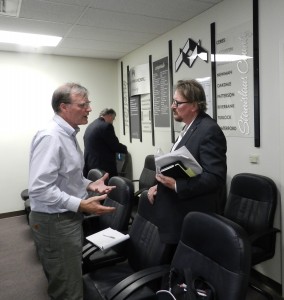
When Stanislaus County Supervisor Jim DeMartini made a surprise appearance at Wednesday night’s meeting of the Stanislaus Water Advisory Committee (WAC), people expected fireworks. DeMartini has been an outspoken critic of the WAC since its formation early this year.
In theory, the WAC is supposed to advise county supervisors on water policy. In fact, it has seemed dedicated to avoiding action of any kind. DeMartini’s recent attempts to establish a moratorium on permits for wells put the committee into a panic. Several members have vested interests in continuing to drill as long as the water holds out.
As it turned out, the fireworks came from Stanislaus County’s Assistant Executive Officer. DeMartini played only a small part in the meeting’s proceedings.
The meeting commenced with a review of the county’s revised Groundwater Ordinance. After the review, Walt Ward, the county’s Water Resources Manager, began to frame a discussion of the proposed moratorium. Using a “who, what, when, where, why” format, it took Ward only five or six minutes to slice and dice the moratorium proposal into a remarkable farrago of split hairs.
For some onlookers, asking why have a moratorium on wells that are depleting the aquifer at warp speed was like asking why apply a tourniquet for hemorrhage, but Ward seemed more than equal to the task of reducing the moratorium proposal to an absurdity.
But just when it seemed as though Ward’s masterful demonstration of splitting hairs even while adding layers of complexity was succeeding, Stanislaus County Assistant Executive Officer Keith Boggs performed what was doubtless the single greatest act of public service at a WAC meeting since the committee’s formation.
After gaining the floor, Boggs explained that he was on vacation and speaking not in an official capacity, but from the viewpoint of a public onlooker. He went on to say that the committee’s evasion of action had become “transparent,” especially with regard to facts about pumping groundwater on the county’s east side.
In a passionate plea for action grounded in the realities of new state demands for groundwater sustainability, Boggs said all the committee and county need to do is approve the newly revised Stanislaus County Groundwater Ordinance.
Citing the relevant section number from memory (9.37.065), Boggs reminded the committee that the ordinance requires well users to report relevant information. The exact wording is as follows:
“All persons, including Public Water Agencies, that extract groundwater within the County shall cause to be prepared and submitted to the County Department of Environmental Resources periodic Groundwater Extraction Statements that are reasonably necessary to monitor the existing condition of groundwater resources within the County, to determine trends, or to develop effective sustainable groundwater management plans and policies.”
Shortly after Boggs rocked the committee with his “cut to the chase” plea, WAC Chairman Wayne Zipser called on a member of the audience who had been waving his hand for permission to speak.
“Al,” said Zipser, “You look like you’re about to bust.”
The speaker identified himself as Albert Rossini, Chairman of the Eastside Water District.
“We have done a tremendous amount of research,” said Rossini. “As far as data…we record what’s on it [the farm]; we multiply the acreage by what’s on it. If it’s grapes, it’s a foot and a half of water; if it’s almonds, it’s four feet of water.”
Rossini wasn’t the first person to inform the committee that the amount of water needed for a given crop is common knowledge. Expressed in acre feet, grapes need about a foot and a half a year, almonds between three and four feet. Despite this widespread knowledge, the committee has insisted it can’t act without knowing how much east side almond growers are pumping.
Following Keith Boggs’ rhetorical tour de force, Rossini’s comments put even more pressure on the WAC to move forward.
Some committee members appear ready to do so. Mike Lynch and Modesto City Councilman Bill Zoslocki said they were ready to support whatever it takes to get additional needed data, including a moratorium.
In fact, despite delays and distractions from the WAC, it is the responsibility of Stanislaus County Supervisors to take action. Sloughing off that responsibility to an advisory committee stacked with members with huge conflicts of interest was an abandonment of the trust voters placed in the supervisors when they elected them.
Keith Boggs is right. The WAC and Stanislaus County Supervisors need to approve the Groundwater Ordinance. They also need to award Keith Boggs a public service medal.

I’ve never seen you jump so high as when Mr. Boggs finished his comments!
Mr. Boggs also called the idea of a moratorium a “red herring” and agreed with committee member Ray Kablanow (a geologist) that enacting a moratorium should be “way down the road.” Even the esteemed hydrologist, Dr. Vance Kennedy, later called a moratorium “a waste of time.” That was a change in position. In the words of Mike Lynch, a moratorium will still (and always has been) a “tool in the toolbox.” If nothing else, the spurs on data collection were received in the ribs. The data may remain anonymous but it seems to be more forthcoming than they were before.
Vance Kennedy has since qualified his comments. Boggs said the moratorium was a red herring because the clear intent of many on the committee was to waste time debating the merits of a moratorium rather than getting to the gist of the problem of overdrafting. If, and it’s a big if, the supervisors exercise their responsibility to attain sustainability, there will not only be a moratorium but a requirement for current industrial-sized well owners to demonstrate groundwater sustainability or stop pumping until they do. They can’t do it. No one believes pumping groundwater in the foothills of eastern Stanislaus County is sustainable except in those cases where the pumps are pulling from reservoirs, lakes, or rivers. Jim DeMartini is right when he says it never should have gotten this far.